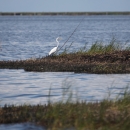States
MichiganIndustrial activities on the Kalamazoo River and Portage Creek released polychlorinated biphenyls (PCBs) to those waterways and the surrounding environment. As a result, the U.S. EPA designated areas downstream of the releases of PCBs as the Allied Paper, Inc./Portage Creek/Kalamazoo River Superfund Site.
The U.S. EPA and the Michigan Department of Environment, Great Lakes, and Energy are working to clean up the contaminants in the river system and/or or halt the risk from them in some way. For the current status of the cleanup process, visit EPA's Kalamazoo Project website.
Meanwhile, the Trustees for natural resources are conducting a Natural Resource Damage Assessment (NRDA). In the NRDA, the Trustees will determine the amount of restoration needed both to return the Kalamazoo River Environment to what it would have been like if the contaminants had not been released and to compensate the public for the loss of use and enjoyment of their natural resources resulting from the contaminants. In order to determine the amount of restoration and compensation required, the Trustees first evaluate the amounts and types of injuries to natural resources that result from the contaminants in the environment. Injuries include things like poor reproduction in bald eagles and mink and fish consumption advisories for anglers in the area.
The Trustee agencies for this NRDA are the U.S. Fish and Wildlife Service, the Michigan Department of Environment, Great Lakes, and Energy, the Michigan Department of Natural Resources, the Michigan Department of the Attorney General, and the National Oceanic and Atmospheric Administration.
We are making progress toward restoration of the Kalamazoo River! The river was returned to its historical channel at the Plainwell Dam site in 2009. The Service and our co-trustees negotiated with the paper companies and U.S. EPA to combine dam removal and river restoration with the PCB removal action completed in the former Plainwell Impoundment of the river. Cleaned banks were revegetated with native grasses, shrubs and trees. The Trustees used bankruptcy settlement funds and additional funding from the State of Michigan to restore a section of Portage Creek in 2018.
On December 11, 2019, the Trustees, U.S. EPA, and the Department of Justice announced a settlement with NCR Corporation that will result in significant additional cleanup work in and along the river and $25 million for additional restoration projects.
The Natural Resource Trustees have selected 14 projects to fund based on the ideas submitted by the public and stakeholders. These projects and the process that the Trustees used to evaluate all of the ideas we received are described in the Supplemental Restoration Plan. This plan also includes an environmental assessment of the expected impacts of the selected projects. The Trustees are now working with project partners to design and implement these restoration projects and will add project updates to this website as the work progresses.
Administrative Record
Administrative Record for Kalamazoo River NRDA
The U.S. Fish and Wildlife Service is in the process of updating webpages, so some content that was previously available is temporarily unavailable.



